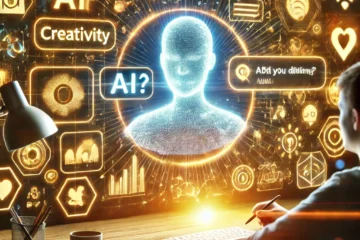
An empathetic AI, represented as a humanoid robot.
Empathy in Artificial Intelligence
Introduction
The concept of empathy has long been considered a uniquely human trait, a powerful emotional capacity that allows individuals to understand and share the feelings of others. It plays a critical role in communication, relationship-building, and emotional intelligence. Empathy has the potential to transform interpersonal dynamics, driving compassionate actions and fostering social cohesion. But what happens when empathy is no longer confined to humans? What happens when it becomes a key element in the realm of artificial intelligence?
Empathy in AI refers to the ability of an artificial system to recognize, understand, and, in some instances, respond to human emotions in a way that is appropriate, beneficial, and sensitive to the emotional context. While current AI models, including conversational agents like ChatGPT, have made significant progress in mimicking empathetic responses, true empathy in AI remains a subject of philosophical, ethical, and technological debate. Can machines, devoid of consciousness or emotional experience, truly embody empathy? And if so, what implications would this have for human-machine interaction, as well as the broader landscape of AI development?
This introduction will examine empathy in AI from various perspectives, exploring its definition, its current applications, and its potential future role. We will address the foundational principles of empathy, the limitations of AI’s understanding of emotional states, and the ethical considerations surrounding the development of empathetic AI systems. Ultimately, we will consider the broader implications of empathy in AI, including how it could reshape the ways in which humans relate to machines, and the potential benefits and challenges of integrating empathy into AI systems across industries.
Defining Empathy in AI
Empathy, in its essence, is not merely the act of recognizing someone else’s emotional state; it involves the capacity to understand and even feel a degree of that emotion. Human empathy is often guided by deep, personal experiences, instincts, and a shared sense of humanity. In contrast, AI’s “empathy” is based on algorithms, pattern recognition, and pre-trained data. While AI can be designed to identify emotional cues such as facial expressions, tone of voice, and word choice, the system’s response is derived from programmed rules or learned patterns rather than genuine emotional resonance.
Despite these differences, the increasing ability of AI systems to simulate empathetic interactions is undeniable. AI-powered systems, such as chatbots or virtual assistants, are now capable of providing responses that reflect an understanding of a user’s emotional state, offering comfort, assistance, or even humour when appropriate. For instance, in mental health applications, AI is being utilized to provide cognitive behavioural therapy or emotional support to individuals who may feel more comfortable speaking to a machine rather than a human.
The Role of Empathy in AI: Current Applications
One of the most significant applications of empathetic AI is in the realm of healthcare. AI systems are being trained to identify emotional signals in patients, enabling them to offer personalized support, monitor emotional well-being, and even make medical recommendations based on a patient’s emotional state. For example, in telemedicine, AI can analyse speech patterns and tone to identify signs of distress or depression, and adjust its responses accordingly.
AI is also being used in education, where empathetic systems can adapt to the emotional states of students, offering encouragement when frustration is detected or providing a calming presence when anxiety arises. In customer service, empathetic AI systems are being deployed to enhance the user experience by responding to complaints or inquiries with sensitivity and attentiveness, making customers feel heard and understood.
The Limitations of Empathy in AI
While AI is making strides in simulating empathetic behaviour, there are significant limitations to its understanding of human emotions. AI lacks true consciousness, meaning it does not possess the emotional experience that underpins human empathy. As a result, AI’s “empathy” is restricted to recognizing patterns and responding in ways that mimic empathetic behaviour, rather than drawing from genuine emotional understanding. Moreover, the ability of AI to assess emotions accurately is contingent on the quality and scope of the data it has been trained on.
There is also the risk that AI’s empathetic responses may be shallow, lacking the nuance and depth that human empathy often provides. Empathy in humans is deeply tied to our ability to connect, to “feel” the emotions of others on a visceral level. AI, by contrast, operates through algorithms and data processing, offering responses that are technically “appropriate” but may miss the subtle human elements of emotional understanding.
Ethical Considerations of Empathy in AI
As AI becomes more adept at simulating empathy, ethical concerns naturally arise. One of the most pressing questions is whether it is appropriate for machines to mimic empathy at all. Can AI’s empathetic responses be trusted? Is it ethical to allow AI systems to simulate emotions in ways that could mislead users into thinking they are engaging with a truly empathetic entity?
Further, as AI becomes increasingly embedded in sensitive contexts like healthcare, therapy, and personal relationships, the potential for misuse also grows. Could AI exploit users’ emotional vulnerabilities for profit or manipulate them in ways that compromise their autonomy? How do we ensure that AI’s empathetic responses are designed to truly serve human well-being, rather than simply mimic compassion for the sake of efficiency or engagement?
The Future of Empathy in AI
Looking ahead, it’s clear that the role of empathy in AI will continue to expand. Advances in machine learning, natural language processing, and affective computing will likely enable AI systems to better recognize and respond to human emotions, creating more nuanced, compassionate interactions. However, the question remains: can AI ever achieve genuine empathy, or will it always be limited to a simulation of human emotion?
The integration of empathy into AI systems presents an opportunity to enhance human-machine interactions, but it also raises significant philosophical, ethical, and technological challenges. As AI continues to evolve, it will be crucial to find a balance between technological innovation and the preservation of human dignity, ensuring that AI serves humanity’s best interests while respecting the complexities of human emotions and relationships.
Bridging the Gap Between Simulation and True Empathy
In conclusion, the potential for AI to simulate empathy holds immense promise in enhancing human well-being, particularly in fields like healthcare, education, and customer service. However, as AI systems become more sophisticated, it is important to remain mindful of the limitations of these systems and the ethical implications of creating machines that simulate emotional intelligence. The journey toward empathetic AI is complex and ongoing, and it will require careful consideration of both the technology’s capabilities and its impact on human society.
The Empathy Test in AI
Empathy, traditionally defined as the ability to understand and share the feelings of others, is a complex trait in human psychology. But what about AI? How can we measure the capacity for empathy in a machine mind? The “Empathy Test” is a proposed approach to evaluating AI’s ability to respond to human emotions, but it faces several challenges due to the unique nature of machine learning and emotional processing.
Key Considerations in the Empathy Test for AI
Unlike humans, AI doesn’t inherently “feel” emotions. However, it can be trained to recognize emotional cues in language, tone, and behaviour, and generate responses that mimic empathetic behaviours. In this way, empathy in AI is often seen as a simulation of human emotional responses, rather than true emotional understanding.
The empathy test evaluates how well an AI system can interpret and react to human emotions in a manner that seems emotionally intelligent. However, while the test measures how empathetic a system appears to be, it doesn’t determine whether the AI truly “feels” the emotions it expresses. This introduces an ongoing debate about whether simulated empathy in AI can ever match the depth of human empathy or whether it is simply an efficient mimicry.
Empathy in AI: The Limits and Potential
As AI systems become more sophisticated, they are increasingly able to engage in emotionally intelligent conversations. However, the challenge lies in moving beyond surface-level interactions to a deeper understanding of emotional complexity. Empathy tests for AI are designed to measure the degree to which AI can respond to various emotional cues, but they do not fully address the core of what it means to “feel” empathy.
To further explore the debate and challenges of empathy in AI, here are some resources:
- The Turing Test and Empathy in Machines
This article explores the role of empathy in human-machine interaction and its potential for AI systems. - Artificial Empathy: Are Machines Capable of Feeling?
A look into whether AI systems can genuinely understand human emotions or merely simulate them. - Empathy in Human-Computer Interaction
This study explores how empathy can be integrated into human-computer interactions and the challenges of doing so.
The Future of AI Empathy
The development of empathetic AI is still in its early stages, but the potential for using empathy simulations in therapeutic settings, customer service, and even companionship is vast. As AI continues to learn from more complex datasets, it may develop increasingly nuanced ways of interacting with human emotions. However, whether AI can ever genuinely “feel” empathy remains a question that tests both the capabilities of machines and the nature of human emotional experience.




0 Comments